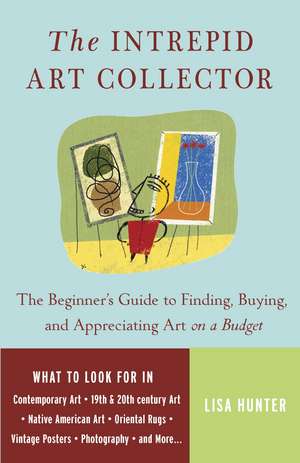The Intrepid Art Collector: The Beginner's Guide to Finding, Buying, and Appreciating Art on a Budget
Autor Lisa Hunteren Limba Engleză Paperback – 30 sep 2006
In The Intrepid Art Collector, Lisa Hunter shows you how to start a fine art collection without spending a fortune. This accessible, jargon-free resource contains up-to-date information on the most popular original art—everything from photography and posters to African art and animation—including where to find it and how to buy it at a fair price. Easy-to-use checklists help you evaluate original art and steer clear of clever fakes. In addition, Hunter has interviewed top dealers, curators, arts lawyers, and appraisers to bring you the best advice on:
• Advantages to buying real art instead of reproductions
• Determining if a piece of art is fairly priced
• Predicting if an artist’s work will go up in value
• Techniques for negotiating a price with a dealer
• Developing your artistic taste, so you’ll know if you’ll still love your purchase ten years down the road
• How to preserve art in your home
• Resources, websites, and magazines that will help you learn more about the market and where to find different types of art
Preț: 115.73 lei
Nou
Puncte Express: 174
Preț estimativ în valută:
22.14€ • 23.12$ • 18.29£
22.14€ • 23.12$ • 18.29£
Carte disponibilă
Livrare economică 25 martie-08 aprilie
Preluare comenzi: 021 569.72.76
Specificații
ISBN-13: 9780307237132
ISBN-10: 0307237133
Pagini: 353
Dimensiuni: 133 x 204 x 21 mm
Greutate: 0.43 kg
Editura: Three Rivers Press (CA)
ISBN-10: 0307237133
Pagini: 353
Dimensiuni: 133 x 204 x 21 mm
Greutate: 0.43 kg
Editura: Three Rivers Press (CA)
Extras
1
Contemporary Art
Technically, “contemporary art” is recent work by living artists—or by their peers who died tragically young. Beyond that, though, contemporary art can mean just about anything: a shark suspended in formaldehyde, a photograph, a video, a ceramic bowl, a mound of elephant dung, or even a painting. That’s why collecting contemporary art is so exciting—because it offers a chance to discover something new and unexpected.
Unfortunately, it’s easy for new collectors to find contemporary art intimidating or merely baffling. When you’re looking at something completely new, how do you tell whether it’s good or not? Even more mysterious is how to tell which artists—out of the thousands now working—are the ones destined for museums and which are destined for yard sales.
Don’t worry if you feel lost at first. Everyone does. Plunge in by going to galleries, museums, and art shows. You may not feel ready to buy yet, but that’s okay. Most artists and dealers are very welcoming to people who are getting started. All you need is willingness to learn.
Learning About Contemporary Art
First, here’s how not to learn about contemporary art: When I was an art history student in New York, my friends and I would dutifully go downtown to contemporary galleries (a prerequisite, we thought, to becoming “intellectuals”). Our courses on Caravaggio hadn’t prepared us for anything we saw there. We had no idea which pieces were good and which were junk, but we were too mortified to admit it. Instead of asking questions, we’d walk around the galleries with a knowing air and murmur, “Very interesting.” This is a dumb—not to mention boring—way to go to galleries.
You wouldn’t expect to learn about any other topic without reading or asking questions. Why should contemporary art be any different?
You probably had a teacher once who told you that if you looked at a work of art long enough, you’d understand it. Not true. You could look at a pile of bricks in a gallery all day without realizing that it’s a witty refutation of another artist’s work, if you didn’t get the reference. Ask questions! Once you understand what the artist was thinking, that pile of bricks may actually be fascinating, amusing, even moving.
A hushed gallery isn’t always the most comfortable place to ask questions, especially when you’re not ready to buy. If you’re shy, ask to see press clippings or background materials. Many exhibitions include an “Artist’s Statement,” in which the artist attempts to describe what he or she was trying to do. (Artists hate writing these, but they’re very helpful to new collectors.) You could also read reviews of the exhibit before you go, to get a general sense of what you’re looking at.
Even better, start by going to art fairs, art shows, and open studio tours. These are more casual than galleries; they’re more amenable places to ask questions and strike up conversations. So are art school exhibitions. Students love to give their opinions about what’s good and bad in contemporary art.
Start with basic questions such as “Can you tell me about the artist?” or “Is this work part of a particular tradition?” Admit what you don’t know. As long as you don’t try to pretend you’re a buyer when you’re not, dealers and artists are usually gracious and willing to answer questions.
If you keep asking questions and engaging yourself in the work, you’ll find that contemporary art is endlessly interesting. There’s always something new.
Where to Find Contemporary Art
The Chelsea neighborhood of New York is the epicenter of contemporary art. A case of botulism at the local deli could knock out half the art world’s power brokers. London and other international capitals—as well as American cities such as Los Angeles, San Francisco, Chicago, and Miami—also have well-respected art galleries. But you don’t need to live in a major city to find contemporary art.
Many midsize cities have lively art scenes. Minneapolis, for example, has one of the most prestigious contemporary art museums in the country (the Walker Art Center), as well as a large creative community. So does Pittsburgh, Andy Warhol’s hometown.
Resorts like Aspen, Santa Fe, and Provincetown probably have more art galleries per capita than Paris.
In addition, university towns draw huge numbers of artists to study and teach. You can find innovative work all over the United States, in places as disparate as Bennington, Vermont; Oberlin, Ohio; and Athens, Georgia. If you’re lucky enough to live near a major art school—such as the Rhode Island School of Design (in Providence) or the Cranbrook Academy of Art (in Bloomfield Hills, Michigan)—don’t worry about saving up your frequent-flier miles to visit New York. The contemporary art world will come to you.
Even middle-of-nowhere places may have significant art- ist colonies. Marfa, Texas, for example, has been called “the most avant-garde art destination in the country.” (Second prize probably goes to the tiny Hudson Valley town of Beacon, New York, home of the Dia:Beacon museum.) Blue-chip sculptor Donald Judd created a massive, minimalist museum in Marfa thirty years ago, and artists have flocked there ever since—even though it’s three hours from the nearest airport.
Wherever you live, you should be able to immerse yourself in contemporary art. A magazine called Gallery Guide provides a good way to find out about what’s happening in your area. It’s published in several regional editions and lists most of the major gallery shows and museum exhibits near you. (See the Resources section for details.)
The Elite Galleries
New collectors are often afraid to go to high-end galleries. They worry that the staff will intimidate them or, worse, will try to sell them something wildly expensive. Neither is the case.
At the elite galleries, the dealer isn’t expecting a walk-in to be a customer. Most of the work on display was already sold through private negotiations before the exhibit opened. Some- times the art doesn’t even belong to the gallery. Top dealers frequently borrow art for exhibitions that will increase the gallery’s prestige in the art world. Going to these exhibitions is like going to a museum, only without the admission fee.
In New York, you can even attend the opening-night parties and meet the artists. Very few openings require invitations; most are free and open to the public. On Thursday and Friday evenings in Chelsea, you’ll see gangs of art students and collectors meandering from one gallery to another, sipping white wine in little plastic cups.
What you won’t see are price tags. Many dealers—even at more affordable galleries—think that listing prices next to the art detracts from the viewing experience. Instead, they type up a price list, which you can get from the receptionist. It spares you any embarrassment you might feel about asking for prices.
“Shopping up”—looking at art above your price range—is a great way to develop your taste and learn about the current art scene. If you find you really love an artist whose work is unaffordable, ask if the gallery has any limited-edition prints by the artist. Unbeknownst to many visitors, galleries have more art in the back room than on display, and it’s not always expensive. Even elite galleries may have items that sell for a few hundred to a few thousand dollars. In some cases, they sell them only through their website, but it never hurts to ask. (A couple of snooty galleries—I won’t name names—might try to dismiss you with the comment, “Everything is already sold.” Don’t take it personally. Just move along to the next gallery.)
If you don’t happen to live near a large city, consider a trip to one of the major art fairs, such as Art Basel/Miami Beach in Miami or the ADAA Show in New York. These high-end fairs are a great way to see art from dozens of elite dealers, all in one place, in a limited amount of time. They’re like a preview of what will be in museums ten years from now.
Finding the Next Big Thing
Most new collectors secretly hope that the contemporary artist they just bought will become the next superstar. They’ll read about some other hot young artist whose work just sold for $100,000 at auction and cringe when they learn that the same piece sold for only a few thousand dollars five years ago. They kick themselves and think, “If only I had walked into that gallery.”
The way artists become stars is utterly mysterious to the uninitiated collector. Most people assume that dealers discover talented new artists and then display their work in a gallery where anyone with foresight and a good eye can buy it. That’s not how the system works. The upper end of the art market is fixed to favor a handful of influential collectors. You can beat the system—and I’ll tell you how—but first you have to understand how it works:
1.Certain elite dealers have a reputation for finding the Next Big Thing. Whenever they sign a new artist, the art world takes notice. The dealer carefully cultivates that interest, trying to place the art in important and highly visible collections. At the same time, he or she carefully controls the supply. As word spreads that major collectors are buying, other collectors start clamoring to get a piece too. And what does the dealer do then? The dealer tells most of them, “No”—they’re not “important enough” to be allowed to own this artwork. Only the “best” collectors will be allowed to buy.
2.Instead of buying something else, the people who’ve been rejected by the dealer start to covet the art all the more. (Many are important people who are accustomed to having anything they want.) Owning this particular artist would be not only a good investment but also a huge sign of social prestige. It doesn’t matter that twenty other artists’ work would look just as good over the couch. At this level of the market, a hot artist is like those shoes you had to have in junior high because all the cool kids were wearing them—only with more zeros on the price tag.
3.Eventually, someone takes a piece of the artist’s work to an auction house to sell. For all the would-be collectors who were turned away earlier, this is their big chance. Their heads spin with visions of jealous neighbors and invitations to join elite museum boards. The bidding goes sky high.
4.Guess what happens next? Once the record-breaking auction price is made public, the value for the artist’s work shoots up. The collectors who were allowed to buy early now have much more valuable investments. Newspaper and magazine articles hail the dealer’s great instincts for spotting the Next Big Thing yet again. You can bet that the next time the dealer signs a new artist, even more collectors will want to buy.
Dealers aren’t the only people with influence, though many art world denizens complain that they are. Sometimes an important critic, curator, or even collector can be a star-maker. A certain British collector, for example, has a contemporary art collection so highly regarded that other collectors monitor his buying habits. Whenever he buys a new artist, dozens of others rush to buy that artist too, which makes the artist’s prices go up, which reinforces the collector’s reputation for picking winners. This collector can’t go wrong. Any new artist he buys rises in value, because he himself is the one creating the market demand.
How can ordinary collectors get in on the Next Big Thing? Those with big ambitions and deep pockets often hire a well-connected art consultant to buy for them. If that’s beyond your budget, and you haven’t been the artist’s best friend since third grade, you’ll have to beat the dealers to the art.
Contemporary Art
Technically, “contemporary art” is recent work by living artists—or by their peers who died tragically young. Beyond that, though, contemporary art can mean just about anything: a shark suspended in formaldehyde, a photograph, a video, a ceramic bowl, a mound of elephant dung, or even a painting. That’s why collecting contemporary art is so exciting—because it offers a chance to discover something new and unexpected.
Unfortunately, it’s easy for new collectors to find contemporary art intimidating or merely baffling. When you’re looking at something completely new, how do you tell whether it’s good or not? Even more mysterious is how to tell which artists—out of the thousands now working—are the ones destined for museums and which are destined for yard sales.
Don’t worry if you feel lost at first. Everyone does. Plunge in by going to galleries, museums, and art shows. You may not feel ready to buy yet, but that’s okay. Most artists and dealers are very welcoming to people who are getting started. All you need is willingness to learn.
Learning About Contemporary Art
First, here’s how not to learn about contemporary art: When I was an art history student in New York, my friends and I would dutifully go downtown to contemporary galleries (a prerequisite, we thought, to becoming “intellectuals”). Our courses on Caravaggio hadn’t prepared us for anything we saw there. We had no idea which pieces were good and which were junk, but we were too mortified to admit it. Instead of asking questions, we’d walk around the galleries with a knowing air and murmur, “Very interesting.” This is a dumb—not to mention boring—way to go to galleries.
You wouldn’t expect to learn about any other topic without reading or asking questions. Why should contemporary art be any different?
You probably had a teacher once who told you that if you looked at a work of art long enough, you’d understand it. Not true. You could look at a pile of bricks in a gallery all day without realizing that it’s a witty refutation of another artist’s work, if you didn’t get the reference. Ask questions! Once you understand what the artist was thinking, that pile of bricks may actually be fascinating, amusing, even moving.
A hushed gallery isn’t always the most comfortable place to ask questions, especially when you’re not ready to buy. If you’re shy, ask to see press clippings or background materials. Many exhibitions include an “Artist’s Statement,” in which the artist attempts to describe what he or she was trying to do. (Artists hate writing these, but they’re very helpful to new collectors.) You could also read reviews of the exhibit before you go, to get a general sense of what you’re looking at.
Even better, start by going to art fairs, art shows, and open studio tours. These are more casual than galleries; they’re more amenable places to ask questions and strike up conversations. So are art school exhibitions. Students love to give their opinions about what’s good and bad in contemporary art.
Start with basic questions such as “Can you tell me about the artist?” or “Is this work part of a particular tradition?” Admit what you don’t know. As long as you don’t try to pretend you’re a buyer when you’re not, dealers and artists are usually gracious and willing to answer questions.
If you keep asking questions and engaging yourself in the work, you’ll find that contemporary art is endlessly interesting. There’s always something new.
Where to Find Contemporary Art
The Chelsea neighborhood of New York is the epicenter of contemporary art. A case of botulism at the local deli could knock out half the art world’s power brokers. London and other international capitals—as well as American cities such as Los Angeles, San Francisco, Chicago, and Miami—also have well-respected art galleries. But you don’t need to live in a major city to find contemporary art.
Many midsize cities have lively art scenes. Minneapolis, for example, has one of the most prestigious contemporary art museums in the country (the Walker Art Center), as well as a large creative community. So does Pittsburgh, Andy Warhol’s hometown.
Resorts like Aspen, Santa Fe, and Provincetown probably have more art galleries per capita than Paris.
In addition, university towns draw huge numbers of artists to study and teach. You can find innovative work all over the United States, in places as disparate as Bennington, Vermont; Oberlin, Ohio; and Athens, Georgia. If you’re lucky enough to live near a major art school—such as the Rhode Island School of Design (in Providence) or the Cranbrook Academy of Art (in Bloomfield Hills, Michigan)—don’t worry about saving up your frequent-flier miles to visit New York. The contemporary art world will come to you.
Even middle-of-nowhere places may have significant art- ist colonies. Marfa, Texas, for example, has been called “the most avant-garde art destination in the country.” (Second prize probably goes to the tiny Hudson Valley town of Beacon, New York, home of the Dia:Beacon museum.) Blue-chip sculptor Donald Judd created a massive, minimalist museum in Marfa thirty years ago, and artists have flocked there ever since—even though it’s three hours from the nearest airport.
Wherever you live, you should be able to immerse yourself in contemporary art. A magazine called Gallery Guide provides a good way to find out about what’s happening in your area. It’s published in several regional editions and lists most of the major gallery shows and museum exhibits near you. (See the Resources section for details.)
The Elite Galleries
New collectors are often afraid to go to high-end galleries. They worry that the staff will intimidate them or, worse, will try to sell them something wildly expensive. Neither is the case.
At the elite galleries, the dealer isn’t expecting a walk-in to be a customer. Most of the work on display was already sold through private negotiations before the exhibit opened. Some- times the art doesn’t even belong to the gallery. Top dealers frequently borrow art for exhibitions that will increase the gallery’s prestige in the art world. Going to these exhibitions is like going to a museum, only without the admission fee.
In New York, you can even attend the opening-night parties and meet the artists. Very few openings require invitations; most are free and open to the public. On Thursday and Friday evenings in Chelsea, you’ll see gangs of art students and collectors meandering from one gallery to another, sipping white wine in little plastic cups.
What you won’t see are price tags. Many dealers—even at more affordable galleries—think that listing prices next to the art detracts from the viewing experience. Instead, they type up a price list, which you can get from the receptionist. It spares you any embarrassment you might feel about asking for prices.
“Shopping up”—looking at art above your price range—is a great way to develop your taste and learn about the current art scene. If you find you really love an artist whose work is unaffordable, ask if the gallery has any limited-edition prints by the artist. Unbeknownst to many visitors, galleries have more art in the back room than on display, and it’s not always expensive. Even elite galleries may have items that sell for a few hundred to a few thousand dollars. In some cases, they sell them only through their website, but it never hurts to ask. (A couple of snooty galleries—I won’t name names—might try to dismiss you with the comment, “Everything is already sold.” Don’t take it personally. Just move along to the next gallery.)
If you don’t happen to live near a large city, consider a trip to one of the major art fairs, such as Art Basel/Miami Beach in Miami or the ADAA Show in New York. These high-end fairs are a great way to see art from dozens of elite dealers, all in one place, in a limited amount of time. They’re like a preview of what will be in museums ten years from now.
Finding the Next Big Thing
Most new collectors secretly hope that the contemporary artist they just bought will become the next superstar. They’ll read about some other hot young artist whose work just sold for $100,000 at auction and cringe when they learn that the same piece sold for only a few thousand dollars five years ago. They kick themselves and think, “If only I had walked into that gallery.”
The way artists become stars is utterly mysterious to the uninitiated collector. Most people assume that dealers discover talented new artists and then display their work in a gallery where anyone with foresight and a good eye can buy it. That’s not how the system works. The upper end of the art market is fixed to favor a handful of influential collectors. You can beat the system—and I’ll tell you how—but first you have to understand how it works:
1.Certain elite dealers have a reputation for finding the Next Big Thing. Whenever they sign a new artist, the art world takes notice. The dealer carefully cultivates that interest, trying to place the art in important and highly visible collections. At the same time, he or she carefully controls the supply. As word spreads that major collectors are buying, other collectors start clamoring to get a piece too. And what does the dealer do then? The dealer tells most of them, “No”—they’re not “important enough” to be allowed to own this artwork. Only the “best” collectors will be allowed to buy.
2.Instead of buying something else, the people who’ve been rejected by the dealer start to covet the art all the more. (Many are important people who are accustomed to having anything they want.) Owning this particular artist would be not only a good investment but also a huge sign of social prestige. It doesn’t matter that twenty other artists’ work would look just as good over the couch. At this level of the market, a hot artist is like those shoes you had to have in junior high because all the cool kids were wearing them—only with more zeros on the price tag.
3.Eventually, someone takes a piece of the artist’s work to an auction house to sell. For all the would-be collectors who were turned away earlier, this is their big chance. Their heads spin with visions of jealous neighbors and invitations to join elite museum boards. The bidding goes sky high.
4.Guess what happens next? Once the record-breaking auction price is made public, the value for the artist’s work shoots up. The collectors who were allowed to buy early now have much more valuable investments. Newspaper and magazine articles hail the dealer’s great instincts for spotting the Next Big Thing yet again. You can bet that the next time the dealer signs a new artist, even more collectors will want to buy.
Dealers aren’t the only people with influence, though many art world denizens complain that they are. Sometimes an important critic, curator, or even collector can be a star-maker. A certain British collector, for example, has a contemporary art collection so highly regarded that other collectors monitor his buying habits. Whenever he buys a new artist, dozens of others rush to buy that artist too, which makes the artist’s prices go up, which reinforces the collector’s reputation for picking winners. This collector can’t go wrong. Any new artist he buys rises in value, because he himself is the one creating the market demand.
How can ordinary collectors get in on the Next Big Thing? Those with big ambitions and deep pockets often hire a well-connected art consultant to buy for them. If that’s beyond your budget, and you haven’t been the artist’s best friend since third grade, you’ll have to beat the dealers to the art.
Descriere
This jargon-free resource is the perfect guide to help novice art collectors navigate the world of galleries, dealers, and auctions to buy original art on a budget.










